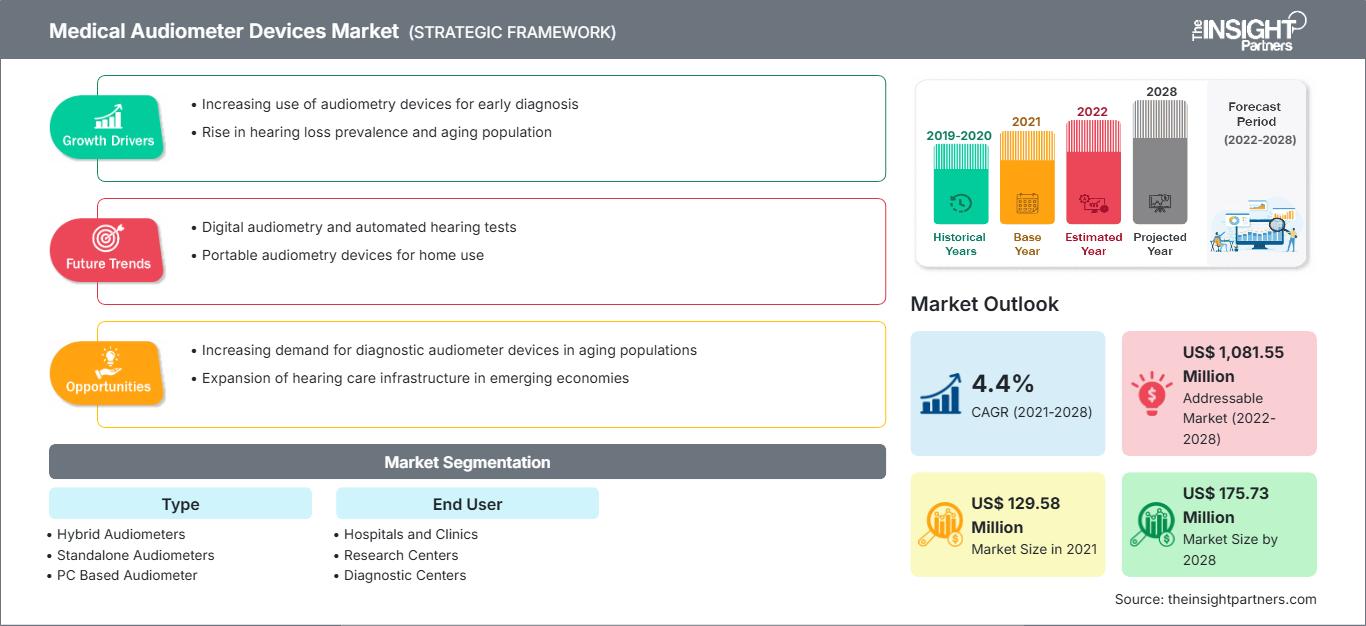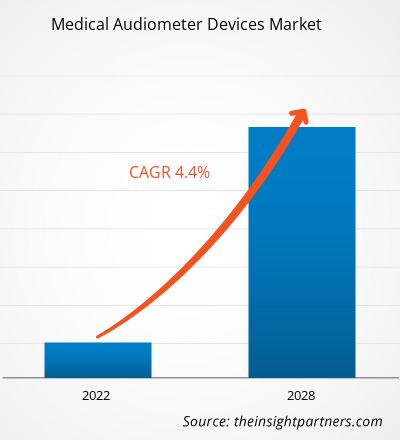Se prevé que el mercado de dispositivos de audiometría médica alcance los 175,73 millones de dólares estadounidenses en 2028, frente a los 129,58 millones de dólares estadounidenses en 2021; se espera que crezca a una tasa de crecimiento anual compuesta (TCAC) del 4,4% entre 2021 y 2028.
Los audiómetros médicos son dispositivos que se utilizan para evaluar el nivel de audición y medir y diagnosticar la gravedad de la pérdida auditiva. Constan de hardware integrado y un botón de retroalimentación para el usuario, conectado a unos auriculares. Un ordenador convencional controla este sistema. La audiometría es una técnica para determinar la capacidad auditiva de una persona. Entre los distintos tipos de procedimientos audiométricos se incluyen la impedanciometría, la audiometría tonal, la audiometría de potenciales evocados auditivos y la audiometría verbal. Diversos avances tecnológicos han propiciado el desarrollo de audiómetros híbridos y audiómetros basados en ordenador para mejorar la comunicación y la calidad de vida.
El mercado de dispositivos de audiometría médica se ha segmentado según el tipo, el usuario final y la geografía. Geográficamente, el mercado se divide principalmente en Norteamérica, Europa, Asia Pacífico, Oriente Medio y África, y Sudamérica y Centroamérica. El informe ofrece información y un análisis exhaustivo del mercado de dispositivos de audiometría médica, haciendo hincapié en las tendencias del mercado, los avances tecnológicos, la dinámica del mercado y el análisis del panorama competitivo de los principales actores del mercado a nivel mundial.
Obtendrá personalización gratuita de cualquier informe, incluyendo partes de este informe, análisis a nivel de país y paquetes de datos de Excel. Además, podrá aprovechar excelentes ofertas y descuentos para empresas emergentes y universidades.
Mercado de dispositivos de audiometría médica: Perspectivas estratégicas

-
Obtenga las principales tendencias clave del mercado que se describen en este informe.Esta muestra GRATUITA incluirá análisis de datos, que abarcarán desde tendencias de mercado hasta estimaciones y pronósticos.
Perspectivas del mercado
Aumento de la prevalencia de los trastornos auditivos
La prevalencia de los trastornos auditivos está aumentando en todo el mundo. Estos trastornos pueden provocar una pérdida auditiva superior a 40 decibelios (dB) en el oído con mejor audición en adultos y superior a 30 dB en el oído con mejor audición en niños. Los trastornos auditivos pueden ser hereditarios o congénitos, o bien, estar causados por enfermedades infecciosas, otitis crónica, exposición a ruido excesivo y la edad avanzada. Las infecciones infantiles, como el sarampión, las paperas y la meningitis; la exposición a ruido excesivo o prolongado; y la otitis media crónica también pueden causar pérdida auditiva. La hipoacusia se ha convertido en la enfermedad más común, especialmente en los países industrializados. Según la Organización Mundial de la Salud (OMS), aproximadamente el 5 % de la población mundial tiene alguna discapacidad auditiva. Se prevé que el número de personas que viven con esta afección médica supere los 900 millones en 2050. Asimismo, según la Hearing Industries Association, en 2019 se distribuyeron más de 4,22 millones de audífonos en Estados Unidos, lo que supone un aumento del 6,5 % con respecto a la cifra registrada en 2018.
Según el informe de la Asociación Estadounidense de Pérdida Auditiva (HLAA), «Datos y estadísticas sobre la pérdida auditiva 2018», aproximadamente 48 millones de estadounidenses padecen algún grado de pérdida auditiva. El informe también menciona que entre 2 y 3 de cada 1000 niños en Estados Unidos nacen con un nivel detectable de pérdida auditiva en uno o ambos oídos. De acuerdo con datos de los Centros para el Control y la Prevención de Enfermedades (CDC), aproximadamente el 16 % de los adultos en Estados Unidos reportan problemas de audición, y 1 de cada 5 hombres y 1 de cada 8 mujeres reportaron tener algún tipo de problema auditivo. La prevalencia de la pérdida auditiva es dos veces mayor que la de la diabetes o el cáncer. Aproximadamente el 11 % de los estadounidenses reportan tinnitus o zumbido en los oídos.
Así pues, la creciente prevalencia de trastornos auditivos y pérdida de audición entre la población está impulsando las ventas de audiómetros médicos.
Perspectivas basadas en tipos
Según su tipo, el mercado de dispositivos de audiometría médica se segmenta en audiómetros híbridos, audiómetros autónomos y audiómetros basados en PC. Se prevé que el segmento de audiómetros basados en PC represente la mayor cuota de mercado en 2021, mientras que se anticipa que el segmento de audiómetros híbridos registre la mayor tasa de crecimiento anual compuesto (TCAC) durante el período de pronóstico.
Información basada en el usuario final
Según el usuario final, el mercado de dispositivos de audiometría médica se segmenta en hospitales y clínicas, centros de investigación y centros de diagnóstico. Se prevé que el segmento de hospitales y clínicas ostente la mayor cuota de mercado en 2021, y se estima que registre la mayor tasa de crecimiento anual compuesto (TCAC) durante el período de pronóstico.
La pandemia de COVID-19 se ha convertido en el mayor desafío a nivel mundial. Dado que esta pandemia ha ejercido una gran presión sobre los sistemas de salud de todo el mundo, priorizar los recursos limitados fue esencial para minimizar los ingresos hospitalarios. Sin embargo, las empresas del sector han adoptado un enfoque innovador: las soluciones de teleaudiología para atender a pacientes con pérdida auditiva. Por ejemplo, las Soluciones de Teleaudiología por Satélite, de la empresa Inventis, se consideran la primera tecnología de este tipo. Esta tecnología permite a los audiólogos interactuar y realizar evaluaciones auditivas completas de forma remota con sus pacientes en tiempo real. Estos avances de las principales empresas del sector han dado como resultado un impacto mínimo de la pandemia de COVID-19 en el mercado de los audiómetros médicos.
Las adquisiciones, colaboraciones, alianzas, lanzamientos de productos y expansiones son estrategias comunes que adoptan las empresas para ampliar su presencia mundial y satisfacer la creciente demanda. Los actores del mercado de dispositivos de audiometría médica han adoptado principalmente la estrategia de innovación de productos para atender la cambiante demanda de los clientes en todo el mundo, lo que también les ayuda a mantener su prestigio de marca a nivel global.
Perspectivas regionales del mercado de dispositivos de audiometría médica
Los analistas de The Insight Partners han explicado en detalle las tendencias regionales y los factores que influyen en el mercado de dispositivos de audiometría médica durante el período de previsión. Esta sección también analiza los segmentos y la geografía del mercado de dispositivos de audiometría médica en Norteamérica, Europa, Asia Pacífico, Oriente Medio y África, y Sudamérica y Centroamérica.
Alcance del informe de mercado de dispositivos de audiometría médica
| Atributo del informe | Detalles |
|---|---|
| Tamaño del mercado en 2021 | 129,58 millones de dólares estadounidenses |
| Tamaño del mercado para 2028 | 175,73 millones de dólares estadounidenses |
| Tasa de crecimiento anual compuesto global (2021 - 2028) | 4,4% |
| Datos históricos | 2019-2020 |
| período de previsión | 2022-2028 |
| Segmentos cubiertos |
Por tipo
|
| Regiones y países cubiertos |
América del norte
|
| Líderes del mercado y perfiles de empresas clave |
|
Densidad de los participantes en el mercado de dispositivos de audiometría médica: comprensión de su impacto en la dinámica empresarial
El mercado de dispositivos de audiometría médica está creciendo rápidamente, impulsado por la creciente demanda de los usuarios finales debido a factores como la evolución de las preferencias de los consumidores, los avances tecnológicos y una mayor conciencia de los beneficios del producto. A medida que aumenta la demanda, las empresas amplían su oferta, innovan para satisfacer las necesidades de los consumidores y aprovechan las nuevas tendencias, lo que impulsa aún más el crecimiento del mercado.

- Obtenga una visión general de los principales actores del mercado de dispositivos de audiometría médica.
Perfiles de empresas
- Compañía de Instrumentos Médicos Benson
- Hedera Biomedics Srl
- Dispositivos de diagnóstico inteligentes
- Natus Medical Incorporated
- INVENTIS SRL
- Datos de auditoría
- MedRx
- INTERACÓSTICA COMO
- RESONANCIA
- Hill Rom Holding Inc.
- Análisis histórico (2 años), año base, pronóstico (7 años) con CAGR
- Análisis PEST y FODA
- Tamaño del mercado, valor/volumen: global, regional y nacional
- Industria y panorama competitivo
- Conjunto de datos de Excel
Informes recientes
Informes relacionados
Testimonios
Razón para comprar
- Toma de decisiones informada
- Comprensión de la dinámica del mercado
- Análisis competitivo
- Información sobre clientes
- Pronósticos del mercado
- Mitigación de riesgos
- Planificación estratégica
- Justificación de la inversión
- Identificación de mercados emergentes
- Mejora de las estrategias de marketing
- Impulso de la eficiencia operativa
- Alineación con las tendencias regulatorias






















 Obtenga una muestra gratuita para - Mercado de dispositivos audiómetros médicos
Obtenga una muestra gratuita para - Mercado de dispositivos audiómetros médicos